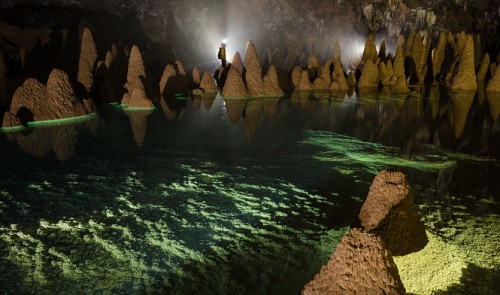The administration of the north-central Vietnamese province of Quang Binh asserted that it has taken concerns raised by the World Heritage Committee over a cable car leading to Son Doong, the world’s largest cave, into serious consideration.
The assertion came after a proposal to build a cable car to the grand grotto prompted a disappointed reaction from the UNESCO body.
Son Doong Cave, situated in the heart of the Phong Nha-Ke Bang National Park in Quang Binh, became internationally known after a group of cavers from the British Cave Research Association conducted a survey on the area in April 2009.
The cave has since been known as the largest cave passage cross-section in the world, according to the National Geographic.
In early August 2013, the first tourist group explored the cave on a guided tour, and tourists can now apply for permits, available on a limited basis, to explore the cave.
Last year only 500 permits were issued for the 2015 season, which ran from February to August.
Despite the administration’s efforts to keep the cave intact, a local developer has made a proposal to construct a cable car to provide easier access to Son Doong, raising eyebrows among both locals and the World Heritage Committee, a UNESCO body concerned with the protection of the world’s cultural and natural heritage.
Myriad concerns
The World Heritage Committee expressed its concern regarding the cable car proposal during its 40th convention session in Istanbul, Turkey, in July 2016.
In a report adopted after the week-long convention, the committee expressed regrets that the Vietnamese government failed to submit a description of the state of conservation of the Phong Nha-Ke Bang National Park as requested, in addition to reiterating concerns about the Son Doong cable car.
With the service proposed to be built within the strictly protected zone of Son Doong, the committee is concerned about “the potential impacts this may have on the property’s outstanding universal value,” according to the report seen by Tuoi Tre News.
Outstanding universal value is a set of selection criteria a site must meet in order to be included on the UNESCO’s world heritage list.
The World Heritage Committee therefore “urges again the [Vietnamese government] to complete environmental impact assessments prior to a decision on the implementation of any tourism development projects and to ensure that development proposals are not permitted if they would negatively impact the outstanding universal value of the property.”
The committee also required that Vietnam revise Son Doong Cave’s sustainable tourism development plan to “ensure an integrated and environmentally sensitive approach to tourism that ensures visitor use remains compatible with the outstanding universal value of the property.”
Lastly, the World Heritage Committee requested that Vietnam submit to the World Heritage Center updated data on the population status of key large mammal species, and statistics on the results of its law enforcement activities to address illegal logging and poaching.
The animals expected to be included in the submission include tiger, Asiatic black bear, Asian elephant, giant muntjac, Asian wild dog, gaur, and saola.
Strictly following requirements
On Wednesday, a source close to Tuoi Tre (Youth) newspaper revealed that the Quang Binh administration had submitted a report addressing the concerns and requests of the World Heritage Committee to the Vietnamese Ministry of Culture, Sports and Tourism.
In the document, the province’s administration said it had taken the cable car concerns seriously, having yet to take any step further than asking relevant parties to conduct a feasibility study and an environment impact assessment for the project.
The administration underlined that it “always respects the need to protect the heritage and to enact protection and conservation measures for the site,” and as a consequence, “the cable car project will only be implemented with approval from the Vietnamese prime minister, and with agreement from UNESCO.”
As for the requested revision of the province’s sustainable tourism development, the administration said it has obtained government support for the plan for the 2010-20 period.
Addressing the concern of illegal logging and poaching, the administration said it has strictly followed the World Heritage Committee recommendation to enact numerous protection measures, helping to “add 16 new flora and 107 fauna species to the Phong Nha-Ke Bang National Park.”
“Thanks to these measures, the amount of illegal logging and poaching in 2016 was cut by 30 percent from 2015,” Le Thanh Tinh, the park director, told Tuoi Tre.






















































